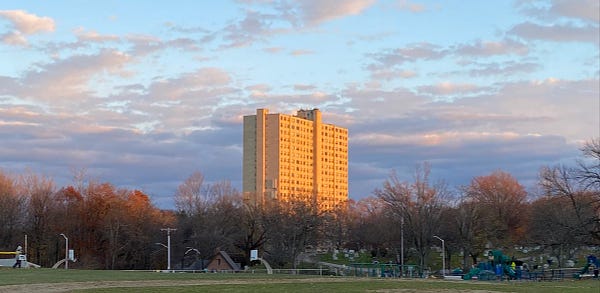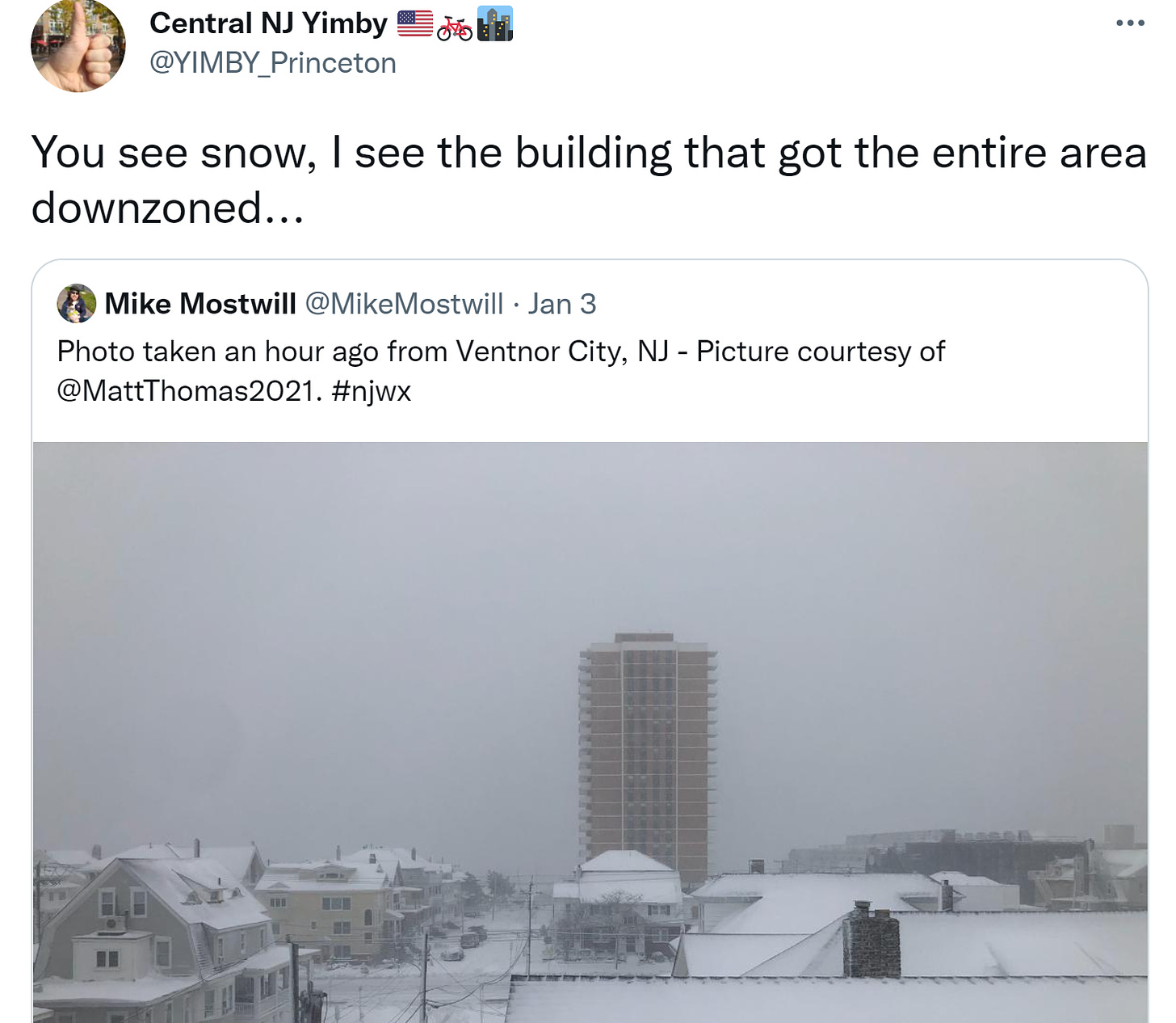Last year I saw this tweet, and have been thinking about it for awhile:
Here’s another one:
I’m going to come back to this to write about it at more length, and have been looking for some information about it. Once you notice this, you see it everywhere. You see these apartment buildings—taller than pretty much anything proposed today except in urban cores or suburban “edge cities” (looking at you, Tysons Corner)—just sort of right in the middle of low-rise suburban sprawl, lacking any connecting urban fabric. Almost all of the ones I’ve seen around the D.C. area are from the 1960s or 1970s.
That tracks with the fact that the 1970s and 1980s saw a huge number of “downzonings”—restricting what the zoning code permits to be built. The idea is that these large apartment buildings upset suburbanites so much that they forced a major change in what was allowed, and few were ever built after this period. Who knows how would have built in alternate universe without low-density codes? I wonder how different these suburban areas would look today, had these huge buildings 50 years ago been a starting point rather than a flash in the pan.
Here’s a major one in my area: the Skyline Towers in Bailey’s Crossroads, in Fairfax County, Virginia. (It’s also the site of an infamous, deadly construction accident.) The towers were built in the early 1970s, and the whole set of buildings (not all of them pictured) includes both apartments and condos. Here are a couple of views of the complex:
I’ve never seen any mention of the zoning and land-use issues surrounding these buildings. It’s a niche thing you’d have to search for to find. It’s an interesting, and unfortunate, hidden story in how suburbs could have been more inclusive and architecturally varied. Perhaps it’s also a lesson in urban design—these resemble “towers in a park” far more than a true urban fabric. They bring density, but they do nothing to alter the fundamentally suburban pattern.
As noted, I’ll be doing a second, longer piece on this. Have you noticed this pheneonon? Do you know anything about it in particular? Leave a comment!
Related Reading:
When Small Towns Wanted Tall Buildings
What If Suburbia Still Looked Like This?
Please consider upgrading to a paid subscription to help support this newsletter. You’ll get a weekend subscribers-only post, plus full access to the archive of over 300 posts and growing—more than one full year! And you’ll help ensure more material like this!








I see their significance in another light: These lonely towers are exemplars of how even "high density apartments" do *not* disturb the character of neighborhoods.
We frequently hear from anti-change voices that tall apartment towers will "ruin the small town character" of a community. These lonely towers, however, show this to be a falsehood. The suburban flavor of surrounding blocks doesn't change in the wake of these towers. Nor does traffic get worse. Instead, these towers are often small apartments for elderly people (see: 3911 Park Blvd, San Diego, California; or 5820 S Windermere St, Littleton, CO 80120; or 5225 S Prince St, Littleton, CO 80123 -- all of late 1960s vintage; all 55+ communities).
We see downsized versions of these towers still going up today, around 5-8 stories but often approved by-right because they are senior-restricted (see: The Vita Apartments, 2100 W Littleton Blvd, Littleton, CO 80120 -- built in 2017, but market-rate rentals around $2500-$3000/month).
What's striking to me is how these lonely towers do not negatively impact their communities. In cases like The Vita, they actually are part of a small shift in local density that is contemporaneous to the revival of a nearby history small town Main St. Despite vociferous opposition by local anti-change neighbors, when such projects get built *none* of the forewarned problems have emerged. Not increased crime. Not increased traffic. Not a loss of 'small town character.'
These lonely towers should be held up as counter-examples to the narrative of fear about how high density apartments "ruin" a place.
What I'm observing now is "density without urbanism" almost everywhere the economy is strong. Land values and market demand are increasing in particular suburbs and municipal governments are selectively embracing big new buildings for increased tax revenue and economic development. But cultural imperatives, zoning regulations, parking requirements, and a lack of viable alternatives to driving in suburbia are powerful forces with no real solution. I've come to the conclusion that we aren't going back to any long lost version of Main Street. The Joel Garreau "Edge City" model is too thick to be jam, but too thin to be jelly. That's sad, but I'm not going to lose sleep over it - especially since I already live in a fantastic pre WWII location where I can walk, bike, and take transit as needed.